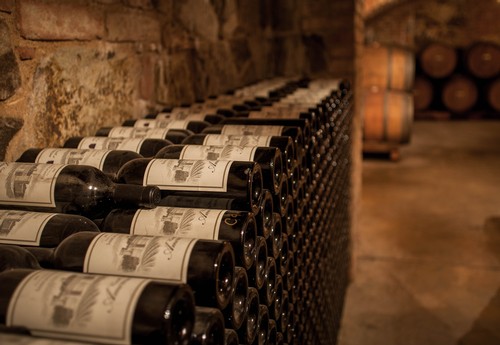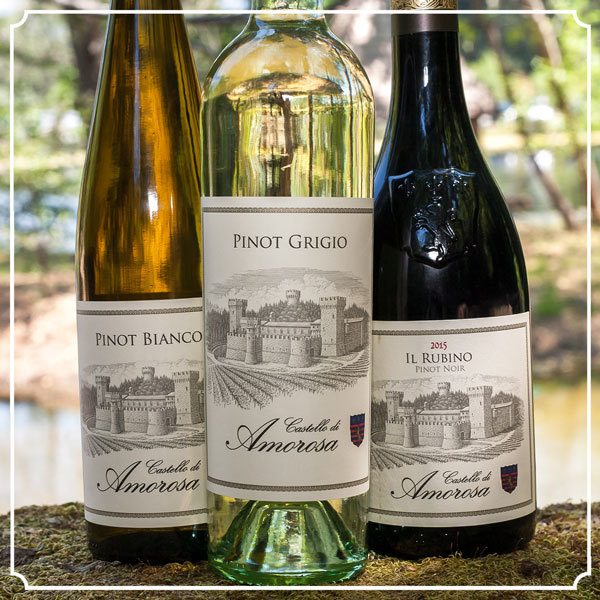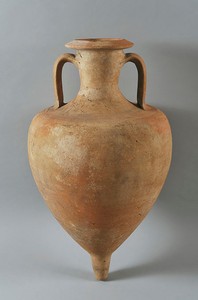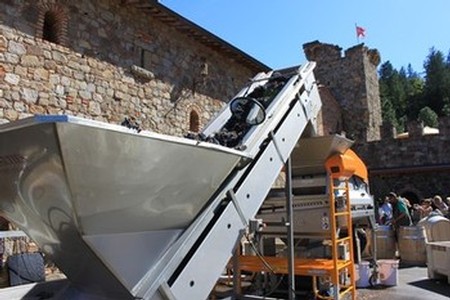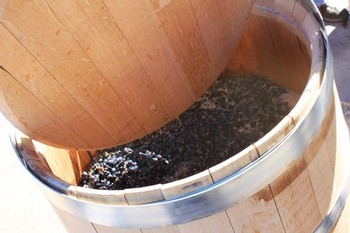Aging Gracefully

Aging Gracefully: How to Store & Age Wine
If you have ever taken a guided tour of the Castello, you will have walked past our Library Rooms, filled with the Castello’s older vintages resting quietly in their cool brick shelves in small, frescoed rooms behind hand-forged wrought iron gates. One of these rooms even houses wines from Dario’s great grandfather’s original winery in San Francisco, dating back over a century. These dimly lit rooms raise numerous questions from inquisitive guests: what is the best way to age wine? How should you store your bottles? How long should you age them? Are those 100 year old bottles still drinkable? All great questions! Now for some answers…

♦ Storing Wines: How To Store Your Wines
Whether you’re planning on enjoying the bottles you brought back from your trip to the Castello next week, next year, or next decade, there are a few simple steps you can take to ensure that your wine will be perfectly ready to drink when you pop that cork:
- Store cork sealed bottles on their side. This will help to ensure that the cork stays moist, preventing oxidation from drying it out and letting air into the wine bottle.
- Store screw cap bottles upright. Since there is no cork, there is no need to store these bottles on their sides.
- Keep your wines out of direct sunlight. The back seat of your car or your kitchen window are definitely not ideal places to keep your favorite bottle of Castello wine. Light can be damaging to wines, altering their delicate chemical balance and potentially even heating up your wine. This is why the lights you see in our Library Rooms are dim and red, and also why most ageable wines such as Cabernet Sauvignon come in deep green bottles; the color of the bottle helps to prevent light rays from penetrating through the glass.
- Store your wines at a cooler temperature. Hot wine = cooked wine, which can be a sad sight to see (and a terrible thing to taste). You’ll notice heat damage to your bottles if the cork appears to be popping up from the bottle. Most wines are best kept around 55° Fahrenheit (13° Celsius). Keeping them cooler also helps to slow the aging process. Storing your bottles in a slightly humid environment (60-70% on average) is also helpful for preventing the cork from drying out at the end not in contact with the wine. If you don’t have a wine fridge or cellar, keeping them in a cool place out of direct sunlight, like a closet or a wine rack in the coolest part of your house, should do the trick just fine.
♦ Aging Wines: How To Age Your Wines
Are a Cabernet Sauvignon and a Pinot Grigio capable of aging the same amount of time? Definitely not. There are certain characteristics of specific grape varietals, as well as how the wines are aged before bottling, that determines a wine’s ageability. The vast majority of wines available in the market today are meant for consumption sooner rather than later. Some, however, absolutely benefit from some quiet time in the cellars.
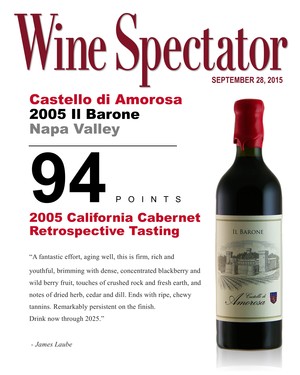
- Bold red wines like our Il Barone Reserve Cabernet Sauvignon and La Castellana Super Tuscan blend are capable of long-term aging, typically up to 15 years from the vintage date on the bottle. This is because these wines have the structure capable of aging due to the tannins imparted from thick skins of the Cabernet grapes as well as the new French oak barrels they’re aged in. As the wine sits in the bottle, these tannin molecules are linking together and falling to the bottom of the bottle as sediment; which is often why so many younger Cabernets tend to pack a bigger “punch” than older vintages (and also why so many older red wines are decanted to remove the sediment). While these wines are fantastic to drink now, they can be even better after laying down for several years, as the structure of the wine smooths out and the tannins are allowed to integrate further.
- Our 2005 Il Barone was recently awarded 94 Points from Wine Spectator Magazine in a ten year retrospective tasting led by wine critic James Laube, which only helps to prove that those bottles of Castello Cabernet in your cellar are getting even more spectacular with age!
- Light-bodied white and sweet wines like our Pinot Grigio and La Fantasia are meant for drinking within the first five years from its vintage date. These wines are prized for their bright and crisp qualities; as they age these characteristics tend to fade. So if you’ve been hanging onto that bottle of 2006 La Fantasia, it might be time to pop that bottle before it’s too late!
- If you’re ever curious about how long to age your favorite bottle of Castello wine, check out our Ageability and Cellaring Chart, which shows the proper time, temperature, and storing positions for our premium and reserve wines.
So whether you’re building your own Tuscan-inspired brick and frescoed underground cellar, or are simply looking to keep your prized Castello wines from cooking in the living room of your apartment, there are plenty of ways to ensure that you’ll be enjoying your favorite bottle at the best time, temperature, and place! Just be sure to drink them before they turn 100!
Crepes with Peaches and Cream


Recipe Date: February 28th, 2018
Difficulty: Easy
Measurements: Imperial (US)
Crepes with Peaches and Cream
From Delightful Repast
The Crepes
(Makes 18 6-inch crepes)
- 2/3 cup milk
- 2/3 cup water
- 2 large eggs
- 1 tablespoon sugar (omit when making savory crepes)
- 1/4 teaspoon salt
- 1 dip-and-sweep cup (5 ounces) unbleached all-purpose flour
- 2 tablespoons unsalted butter, melted and slightly cooledThe Fresh Fruit Filling
- Thinly sliced perfectly ripe yellow peaches or other soft fruit
- Freshly squeezed lemon juice
- Sugar
The Garnish
- Powdered sugar
- Whipped cream
- Tip: Or use an immersion blender in a 1-quart glass measuring cup, as I prefer; pulse until batter is smooth, scraping down the sides once or twice, about 20 seconds total.
2. Crepes can be made any size, but I use an 8-inch nonstick omelette pan or 8-inch nonstick fry pan to make 6-inch dessert crepes. Heat pan over medium-low to medium heat until thoroughly heated (droplets of water sprinkled onto the pan will sizzle and disappear immediately), about 2 minutes. Brush lightly with just a little melted or softened butter.
- Here it is now, The Swirl: Holding pan off heat, quickly pour into the center of the pan 1/8 cup of batter, and immediately begin swirling, tilting and rolling, the pan until the batter covers the bottom of the pan evenly. Cook for about 30 to 60 seconds, or until browned on the bottom and looking dry on the top, especially the edge. Using both hands, lift the edge with your fingers and turn it over. The second side will need less time to cook.
- Tip: I use a 1/8-cup from my stainless steel measuring cup set. It is exactly the right amount to make crepes that are just a bit over 6 inches in diameter. And I use the GIR silicone mini spatula to start lifting the edge, then take hold of it with the thumb and index finger of both hands and quickly flip it over.
4. Prepare a dessert filling; in this case, fresh peach filling. You need only about 3 or 4 tablespoons of filling per crepe, and there are 2 crepes per serving. So do the math. If you are making dessert for two (that’s 4 crepes), thinly slice enough peaches to make 1 cup or so. Add a squeeze of fresh lemon juice and sugar to taste; let stand at room temperature for about 30 minutes to macerate.
You can even cook the macerated filling for 4 or 5 minutes if you prefer your peaches cooked. It’s definitely the way to go when your peaches are less than stellar.
5. To assemble: Lay down a crepe, pretty side down (that’s the first side cooked), spoon 3 to 4 tablespoons of fruit onto one half. Fold over other half to cover. Fold in half again to form a wedge (that’s the “Crepes Suzette fold”). Place 2 crepes on each dessert plate. Dust with powdered sugar and add a spoon or two of whipped cream.
Related Products
The Big Night


The Big Night
Steak, Magnums, & Cigars
Enjoy the New York-style steakhouse experience with our own Napa Valley flair. We are pairing juicy steaks with our bold Castello wines for a classic evening of food, wine, and cigars under the summer sky in our beautiful Courtyard.
- Arrive to a welcome wine reception and receive a trio of complementary cigars for the evening
- Sit down to a delicious al fresco steak dinner in the Courtyard
- Tempt your taste buds with a curated three course meal paired with large format Castello wines and cigars
- Enjoy live piano music to accompany the evening
Friday, June 18, 2021
7:00 P.M. to 11:00 P.M.
*Only 80 Spots Available*
$250/Wine Club Member, $275/Guest
Reservations Required.
Call Wine Club at 707-967-6274 for more information.
*Our menus are pre-set and we can accommodate dietary restrictions and food allergies upon advance request*
Get Notified The Big Night
The Quick Chill

The Quick Chill: How to Quickly Chill Wine to Serve
One of the most frequently asked questions we get in our tasting room is how to age, store, and serve our wines, which can vary greatly depending on the type of wine being talked about (for a handy reference, check out our Ageability and Cellaring Chart to see just how to store and serve your favorite bottles of Castello wines). But if you’re looking for the fastest way to chill your favorite wine bottle tonight and need a quick tip on the best temp to serve it, look no further! We’ve got a few wine serving secrets that will teach you how to quickly, and properly, chill a wine bottle before serving to get the most out of every drop…

First and foremost, “Room Temperature” is normally not the correct temperature to serve your red wines! If the room your wine has been stored in is on the warmer side (above 65° F), your wine will be too warm and those beautiful fruit flavors will be masked by a stronger presence of alcohol. Conversely, your white wine stored in your refrigerator will most likely be too cold if you pop the cork right after you take it out, again masking the fruity or floral notes and structure with simply a refreshing temperature (think about that ice cold bottle of Pinot Grigio you consumed much faster than anticipated).
Here’s a good rule of thumb for how to quickly chill wines before serving when you don’t have access to a wine fridge:
♦ Red Wines: if your red wine is at room temperature and your room is warm, pop the bottle in the fridge for 15 minutes. This allows the temperature of the wine to drop just enough to reveal the beautiful layers within the bottle. For lighter bodied reds (especially Pinot Noir), it’s best to err on the cooler side, as the flavors and aromas of these wines tend to be more delicate and benefit from a slightly cooler temperature.
♦ White Wines: if your white wine is coming straight from your fridge, let it sit at room temperature for 15 minutes, bringing the temperature up just slightly so you can enjoy all of the wonderful fruits and flavors in your glass. If you’re in need of a super quick chill and forgot to put that wine bottle in the fridge in the first place, don’t panic! Wrap a wet paper towel around your room temp bottle and pop it in the freezer for 15 minutes and it will be the perfect serving temp before you know it! Just be sure to set a timer so you don’t forget about it!
Most red wines should be served between 60-65° F. Most white, rosé, and sweet wines should be served between 47-52° F. The Quick Chill is an easy trick that should help to make sure you get the most enjoyment from every sip!
Salute!
Pinot Perfection

Pinot Perfection: The 3 Different Wines
Wine grapes can be an incestuous little bunch. Genetic mutations and cross-breeding varieties can spring forth entirely new and delicious fruit (a famous example being the marriage of Sauvignon Blanc and Cabernet Franc to produce the illustrious Cabernet Sauvignon grape), and considering winemaking and viticulture have been progressing steadily for millennia, it’s no wonder we have such an abundance of varieties to choose from today.
One of the most intriguing family trees (or vines…) is that of the Pinot family, with the noble Pinot Noir reigning supreme at the head of the table. This dark-skinned grape was one of the first to be cultivated for the purpose of making wine, with records dating as far back as the first century AD in Roman-occupied Gaul (France). From these humble beginnings, the grape has mutated over generations to produce a number of clonal offspring, including Pinot Gris and its more elusive sibling, Pinot Blanc. Here at the Castello, we are fortunate enough to offer all three of these delicious family members in our tasting room, and call two of them by their Italian names of Pinot Grigio and Pinot Bianco.

The names of these three Pinots are in many ways referring to the color of the berry’s skin, with Noir (French for “black” or “dark”) clusters having dark-skinned berries, Gris (“grey”) traditionally ranging from pinkish-grey to deeper purple berries, and Blanc (“white”) having light-skinned berries. In fact, due to Pinot Gris’ darker color, it can also be made as a rosé-style wine, though it is most commonly fermented without skin contact, and so is seen primarily as a white wine.

Our Pinot Grigio (Gris) comes from Anderson Valley in Mendocino County, roughly a two hour drive northwest of the Castello. Here, the cool, coastal climate helps to produce a refreshingly dry and crisp white wine, bursting with zesty notes of citrus and green apple. Light in body and with a racy acidity, it is an excellent accompaniment to light appetizers and soft cheeses.

While not as famous as zesty Pinot Grigio, Pinot Bianco (also known as Pinot Blanc or Weißburgunder) is slowly gaining recognition around the world as an elegant alternative, offering a bit more body and complexity while still showing fruit-forward and refreshing notes on the palate. Because of these characteristics, it can often be mistaken for a lighter-styled Chardonnay. We try to craft our Pinot Bianco in the style of the Pinot Bianco wines from the Alto Adige region of northeastern Italy where it is most commonly grown, striking a balance between creamy and crisp, and allowing the fresh fruit flavors of apple, pear, and white flower to shine through.

Pinot Noir (Nero in Italian) is a beautiful yet tricky grape to cultivate, with its thin skins demanding a cooler climate and more attention than its lighter-skinned relatives. For this reason, we source our Pinot Noir fruit from a variety of vineyards that all have a coastal influence on their climate and soils. We make a number of limited production Pinot Noir wines from these vineyards, including the family-owned Terra de Promissio vineyard in the famed Petaluma Gap of Sonoma County (for more, see Mary Davidek’s blog post: “Terra de Promissio: Checkmate Castello”). We also source from several of our own estate vineyards, located in Anderson Valley, Los Carneros, and Green Valley of Russian River Valley near the Sonoma coast. Each of these locations can lend subtle nuances to the finished wine, which is why we also produce our Il Rubino Pinot Noir, which combines the best characteristics of these locations into a beautiful “ruby”-colored blend.

Pinot Noir is also one of the main grapes used in making the sparkling wines of Champagne, along with Chardonnay and, to a lesser extent, Pinot Meunier. We have recently released a new sparkling wine named Spumante del Castello in honor of our 10 year anniversary which is made in the methode traditionelle (formerly champenoise) and is comprised of 25% Pinot Noir and 75% Chardonnay from our vineyards in the southern end of Napa Valley.
With so many options to choose from, it’s no wonder that the Pinot family is so well-loved and respected throughout the wine drinking world. We are proud to feature this clonally diverse clan here at the Castello, and look forward to welcoming Pinot enthusiasts and novices alike to our tasting room to get to know our Pinot famiglia.
Bison Burgers with Cabernet Onions


Recipe Date: February 17th, 2017
Difficulty: Easy
Serving Size: 4
Cook Time: 00:45
Measurements: Imperial (US)
Bison Burgers with Cabernet Onions Recipe
Sommelier Mary Davidek shares her recipe for homemade bison burgers, complete with delicious Cabernet onions cooked in a skillet.
Ingredients
- 1 tbsp grapeseed oil
- 3 cups sliced onions (roughly 2 onions)
- 3/4 cup dry red wine
- 1 lb ground bison
- 2 tbsps chopped onions
- 1/4 tsp coarse kosher salt
- 1/4 tsp dried oregano
- 1/4 tsp garlic powder
- 4 brioche buns or soft rolls
- 6 ozs cheese
- dijon mustard
- romaine lettuce or escarole
Directions
Heat grapeseed oil in a skillet over medium-high heat. Add onions, sprinkle with salt, and sautée for 10 minutes. Reduce heat to medium, add wine, and sautée another 15 minutes, stirring occasionally until liquid has absorbed and onions are tender. Remove from heat and set aside (can be made a day ahead and chilled).
Combine ground bison, oregano, diced onions, salt, pepper, and garlic powder (if you have any leftover liquid from the sautéed onions, you can add a splash in as well). Divide into four portions and shape into 1/2 inch thick patties. Sprinkle burgers with salt and place on a grill that has been sprayed with non-cook spray or oil, cook until desired doneness (roughly 150°F for medium). Burgers can also be cooked in an oiled large, heavy skillet over high heat, roughly two minutes per side.
Preheat broiler. Open buns and arrange, cut side up, on rimmed baking sheet. Place cheese slices on bun tops. Broil until cheese melts and bottom halves are lightly toasted, about 1 minute. Spread bottom halves with mustard. Top each with a few lettuce or escarole leaves, then the burger. Spoon onions on top of burgers, dividing equally. Cover with bun tops; press lightly.
Serve with French fries and a glass of your favorite medium to full bodied red wine, such as our Il Brigante or Napa Valley Merlot.
Recipe adapted from Epicurious
Cedar Plank Salmon

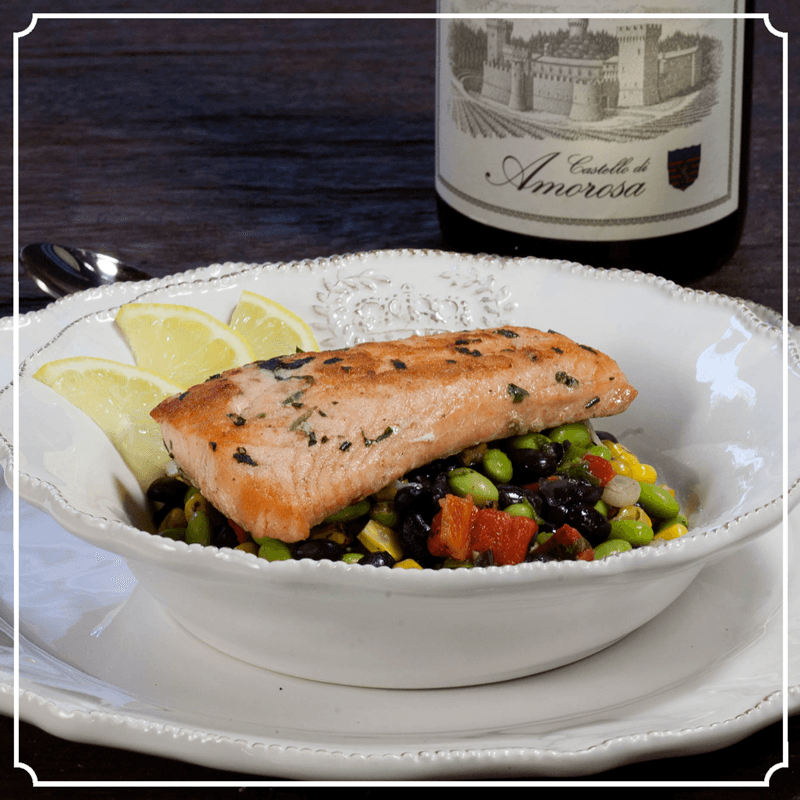
Recipe Date: May 10th, 2016
Difficulty: Easy
Serving Size: 4
Cook Time: 00:30
Measurements: Imperial (US)
Grilled Cedar Plank Salmon
Ingredients
- 1 large filet of salmon
- 1 cedar plank
- 1 tbsp olive or grapeseed oil
- sea salt and pepper
- sprinkle of garlic powder, parsley and dry mustard
- 1 tbsp lemon juice
Directions
- Soak the cedar plank in water or dry white wine for 1 hour prior to grilling.
- While plank is soaking rub olive oil over salmon then add all spices.
- Allow salmon to sit for 30-45 in refrigerator.
- Once cedar board is done soaking grill on each side for about 3-5 minutes.
- Add salmon to the cedar board skin side down.
- Place the board on the grill for 15-20 minutes on a 350 degree grill until salmon flakes easily.
- Remove the remaining skin and serve!
Concrete Egg Fermentation

Concrete Egg Wine Fermentation Tanks
If you have been lucky enough to explore our Grand Barrel Room on a tour and tasting recently at the Castello, you may have noticed a few new additions to the stunning 12,000 square foot room. Right next to where our guests have the chance to taste wine straight from the barrel, there sit several large, concrete, egg-shaped containers. These concrete eggs are wine fermentation tanks, and they are used to ferment a special selection of Castello’s award-winning wines.
Concrete? You might ask. What can concrete do for wine? Well as it turns out, concrete is a fantastic alternative to oak or stainless steel in winemaking. Without the “oaky” impact on a wine from barrel aging, the concrete allows the wine to retain its fruity characteristics and the inherent characteristics of the grapes are allowed to shine, making it an especially useful fermentation method for showcasing the terroir of single vineyard wines.
Concrete eggs are an interesting mix of ancient and ultra-modern winemaking techniques, since the first wines were actually fermented in pottery jars called amphorae. The egg shape is a newer modification, which allows the wines inside to have a natural convection current as the carbon dioxide released during fermentation helps to naturally stir the wine and mix in the sediment, or lees.
“Graeco-Italic” Wine Amphora, 2nd century B.C.
We originally had two concrete eggs in our Grand Barrel Room, and focused on several single vineyard wines, including our Ferrington Vineyard Dry Gewürztraminer and Tyla’s Point Pinot Bianco. These aromatic varietals work especially well with this fermentation method, because the concrete enhances the floral aromas and even increases the mineral characteristics in these wines. The elegant complexity of these wines from their fermentation in the eggs has led to them both winning high praise from tasting panels and our guests.
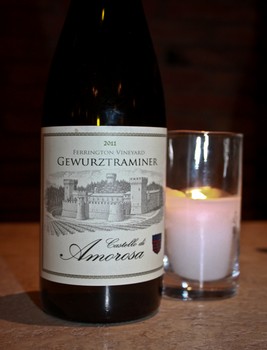
Our 2011 Ferrington Dry Gewurztraminer
This past year we have also produced a limited amount of Chardonnay, called “La Rocca” or “the fortress.” Our Winemaker, Peter Velleno, explains that “the reason for the Chardonnay is that the use of concrete (or more specifically the lack of oak barrels) allows the flavor of the vineyard to be the star. Chardonnay needs to have a rich mouthfeel, so it makes sense to try it in concrete, where there will be no oak flavors or aroma, but still the benefits of aging on the lees.” Aging wine on the lees, or the yeast and sediment that settles to the bottom of the barrel during fermentation, imparts a creaminess and complexity that can’t be found in stainless steel. This year we are excited to be fermenting some of the Chardonnay fruit from the Bien Nacido vineyard in one of our eggs.
So keep an eye out the next time you visit the Castello, and if you take a tour down into the Grand Barrel Room you’ll be able to check out this unique fermentation technique that helps to make our Italian-style wines even more incredible!

Red Wine Barrel Fermentation

How to Ferment Wine: Our Red Wine Oak Barrel Fermentation Process
During the Harvest season, there are always exciting things going on around the Castello, and today on the Crush Pad was no exception. Today, for the first time at the Castello, our winemaking team reserved a small lot of our Don Thomas Vineyard Cabernet Sauvignon for fermentation directly in French Oak Barrels.
Traditionally, the fermentation process takes place in stainless steel tanks, where the must (skins and seeds of the grapes) are cold-soaked with the juice before yeast is added. The cap, or layer of skins and seeds that get pushed to the top of the tanks from the activity taking place during fermentation, is broken up by either the punch-down or pump-over method, both of which ensure an even distribution of the color and flavors we wish to impart into our red wines. After five to eight days in these fermentation tanks, the juice is pressed from the skins and seeds and pumped into French Oak barrels for aging in the Castello’s extensive underground cave and cellar system.
What is barrel fermentation? Barrel fermentation means that the freshly destemmed grapes and their juices are pumped directly into French Oak barrels whose heads have been removed. Dry ice is added to cool the berries before the barrel heads are secured to seal in the must. The barrels are then laid on a rack that allows them to be rolled back and forth daily to ensure the cap stays moist and the oak is evenly introduced to the fermenting must and juice. Typically, two full barrels of must and juice will amount to one barrel of wine. The process of fermenting the juice in oak barrels helps to impart an added silkiness to the tannins and a rounder, more lush mouthfeel, especially to Bordeaux varietals. This extremely labor-intensive method of fermentation is typically reserved for only the most exclusive of wines, and the highly-acclaimed Cabernet Sauvignon from the Don Thomas Vineyard is an exceptional example of the quality of grapes deserving of such treatment.
The Don Thomas Cabernet Sauvinon clusters are conveyed into the berry sorter/ destemmer as a lucky tour group watches
The new French Oak barrels are filled directly from the destemmer
Our Cellar Supervisor, Chema, overseeing the juice and must being pumped into a special French Oak barrel that has a door in place to make filling and emptying easier
The deconstructed barrel waiting to be resealed with the juice and must inside
Dry ice is added to the must before the barrels are resealed to help cool off the berries
Resealing the barrel heads before they are sent into the cellars to begin the fermentation process
The barrels are stored in a special temperature-controlled room in the Castello’s cellars during the fermentation process.
Sangiovese-Braised Short Ribs


Recipe Date: February 16th, 2012
Difficulty: Easy
Serving Size: 2
Cook Time: 03:30
Measurements: Imperial (US)
Sangiovese Wine-Braised Short Ribs with Cranberries and Onions
Ingredients
- 1 1/2 lbs. (4) Bone-in short ribs
- 1 tbsp. Grapeseed Oil
- 1 tbsp. Coarse Sea Salt
- 1 tsp. Cocoa powder
- 1 tsp. Paprika
- 1 tsp. ground ancho chili
- 1 tbsp. grape seed flour
- 1 cup brown onions, thinly sliced
- 1/2 cup dried cranberries
- 2 cups Sangiovese wine
- 1/4 cup aged balsamic vinegar
- 1/2 cup water
Directions
Preheat oven at 375°F.
Season short ribs with cocoa powder, paprika, ancho chili, salt, and pepper; rub all over using your hands and let stand at room temperature for 20-30 minutes.
Heat 2 tbsp. of grape seed oil over medium-high heat in a Dutch oven; sear ribs until golden and crispy, about 4 minutes on each side. Transfer to a plate and set aside.
Return pot to heat and sauté onions for a couple of minutes, then add cranberries and sauté for 1 more minute. Sprinkle grape seed flour and stir with wooden spoon. Return ribs to pot and add wine, balsamic vinegar, and water. Stir and make sure to scrape any bits from the bottom of the pot. Cover and transfer to oven; cook for 3 hours. Remove from oven and allow to rest for 5 minutes, uncovered, before serving.
Serve two wine-braised short ribs on each plate and top with cranberries and onions. Spoon some of the Sangiovese sauce and garnish with green onions.


